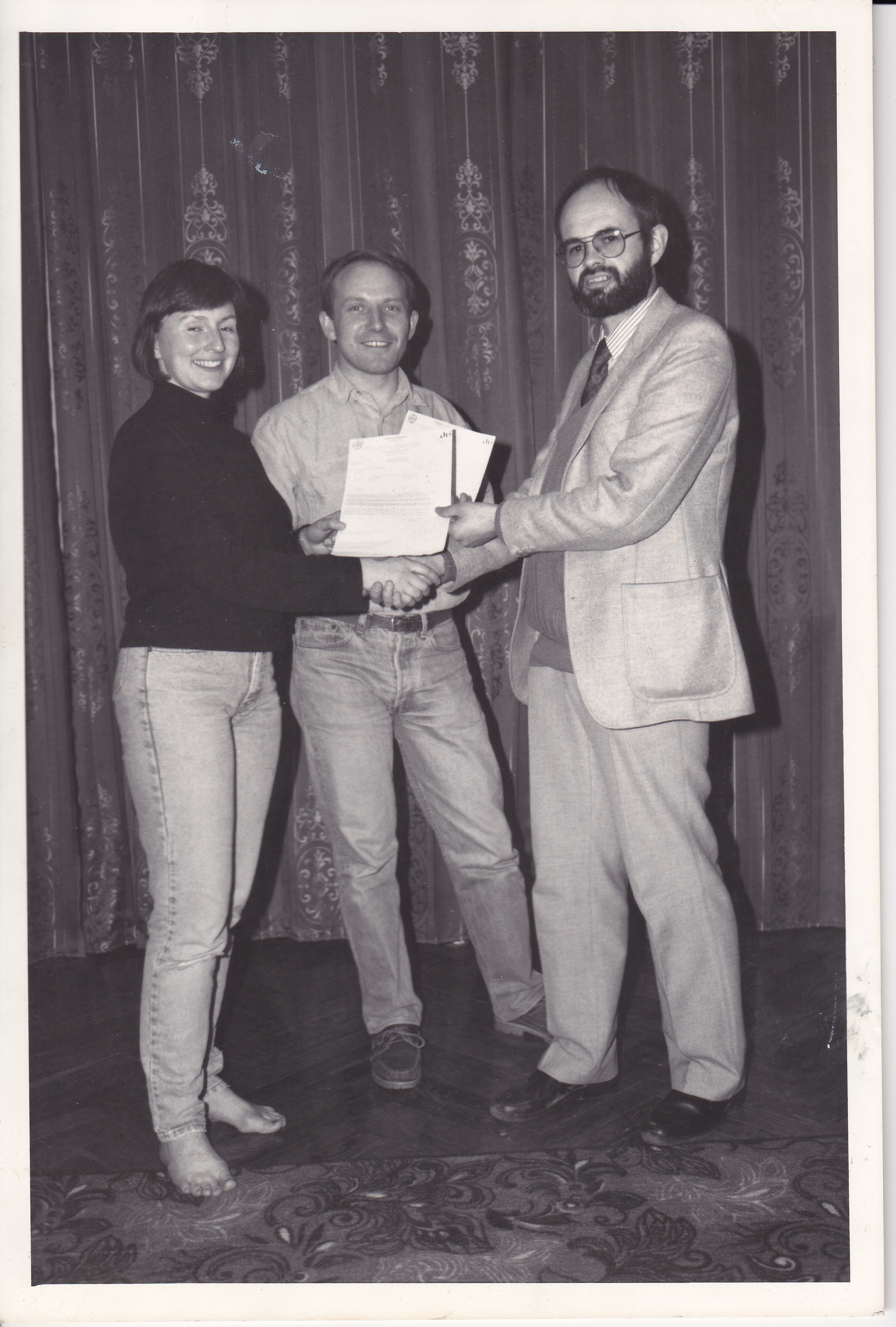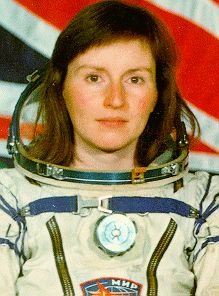
After returning to Earth Helen Sharman visited the Harrogate Ladies’ College club station used for GB0JUNO. From left to right: Anna-Karin G7IRR, Helen Sharman GB1MIR, Richard Horton G3XWH, Katy G7NST
Helen Sharman GB1MIR became the United Kingdom’s first astronaut when she blasted off from Baikonur in Kazakhstan at 1250 GMT on May 18, 1991 on her way to the Mir space station. Also on the flight were Russian cosmonauts Anatoly Artsebarsky U7MIR and Sergei Krikalev U5MIR.

Richard Horton G3XWH hands over GB1MIR licences to Helen Sharman and back-up astronaut Timothy Mace in Star City
She won her place in space when in 1989 she answered as advertisement she heard on the car radio that said “Astronaut wanted. No experience necessary.”
Helen was selected from over 13,000 applicants to join the scientific space mission Project Juno. She spent 8 days in space and operated Amateur Radio using her special call sign GB1MIR in the 2m band. While in space she carried out a range of experiments that included studying how weightlessness affects people, plants and the growth of crystals.
The Radiocommunications Agency issued Helen with the callsign GB1MIR even though she hadn’t passed any amateur radio examination. Richard Horton G3XWH traveled to Star City near Moscow a month before the launch to present her with the special Amateur Radio license GB1MIR to operate from the Mir Space Station. A radio licence was also presented to Timothy Mace who was the back-up astronaut for the flight.
An article about this historic mission appeared in the May 1991 edition of RadCom. This document is Copyright of the Radio Society of Great Britain and can be downloaded here with their kind permission.
Nine special four-letter suffix callsigns (GB*JUNO) were issued to UK schools wishing to participate in contacts with Helen on the Mir Space Station:
• GB0JUNO Harrogate Ladies’ College
• GB1JUNO Bigyn Co Primary School, Llaneli
• GB2JUNO Alford Academy, Aberdeenshire
• GB3JUNO Hewett School, Norwich
• GB4JUNO Canterbury High School
• GB5JUNO Belfast Royal Academy
• GB6JUNO Looe School Sunrising, Cornwall
• GB7JUNO The Royal Grammar School, Guildford
• GB8JUNO Orwell Park School, Ipswich
Using the callsign, GB0JUNO, six pupils with Full amateur radio licences at the Harrogate Ladies’ College established the initial contact with Helen and then passed transmission to the other eight schools involved in the experiment. Katy G7NST asked Helen the first question: “If you had no clock on board Mir, what would give you sense of time in space?”.
These Project JUNO recordings have been made available by Richard Horton G3XWH:
BBC Radio 5 show 5aside 1991-05-13
Atlantic 252 1991-05-21
BBC Radio Leeds 1991-05-22
Harrogate Ladies College GB0JUNO amateur radio contact with Helen Sharman GB1MIR 1991-05-23
Peter Franklin G1FOA has made available this recording of Helen Sharman GB1MIR, made from his 145 MHz mobile station.
As well as schools Helen also spoke to other radio amateurs among them was Chris Lorek G4HCL who worked for the then amateur radio dealer South Midlands Communications SMC in Chandler’s Ford, Hampshire. Chris has written a few words about his memorable contact with Helen:
I remember it fondly! I and my three children all chatted with her on 2m using my club station call G4SMC on her next-but-last Mir pass over the UK before she came down. Steven (10 years old), David (8 years old) and Carolyn (5 years old) all said hello to her, each giving their name and age, with Steven asking whether there was a particular challenge she may have had. Helen replied, knowing it was very young children, that one difficult challenge she’d had was putting her socks on as she floated around the station!
I used a DOS PC tracking program with a 286 PC with a monochrome display, and used NASA Keps from each of the five Mir modules, which according to NASA were each traveling at up to several miles apart, with subsequent AOSs at my location of around 10-12 secs variance. So I averaged them, gave a single short call in phonetics “Golf Four Sierra Mike Charlie” at the precise moment I hoped she’d be coming over the horizon, and she immediately came straight back.
My next door neighbour had seen my 10m tower-mounted azimuth/elevation antenna system moving around (9 ele crossed 144 MHz Yagi, 19 ele crossed 432 MHz Yagi, 28 ele 1296 MHz loop Yagi) and when seeing me outside chopping logs later he asked if I’d been talking to anyone interesting. I quite casually told him that I and my kids had had a short chat with Helen Sharman up on the Mir Space Station. I knew he worked in Southampton but I didn’t know he was the Producer for the BBC ‘South Today’ news show. He said “You mean you actually had an interview with her?”. I replied “I suppose I did”. Within the hour there was a BBC film crew round at my house and that night we were on the air TV-wise. We had filmed interviews at my house, then transferred to the SMC showroom (it looked a lot more technical with all the equipment and 20m tower) for the staged contact, when they used my Dictaphone recorded audio for the soundtrack of Helen replying to us.
The following day I was told that Helen had been calling me back on her next and final pass, unfortunately I wasn’t listening as I’d been carrying on chopping my logs.
The GB1MIR QSL card was displayed at the SMC Chandler’s Ford amateur radio showroom, but after SMC decided to pull out of the amateur market it unfortunately disappeared, it was probably in store somewhere until someone had a clearout. A real pity.
I subsequently met Helen when she was sitting two chairs away from me on the stage at Southampton Guildhall, where she was being presented with an honorary Doctorate by Southampton Institute for her work. I thought she looked familiar as we were both walking to the stage a little earlier! After the ceremony we had a light lunch together and she certainly recalled the contact, she kindly signed my Graduation Ceremony book back leaf for me (it was the only blank paperwork I had at the time) saying “To Steven, David and Carolyn, it was nice chatting with you from space. Helen Sharman”
I hope the above gives a bit of background information, I really didn’t think much of it at the time although the BBC certainly seemed to. I wish I’d kept hold of the QSL card though!
In a Vega Science Masterclass video Helen gives a vibrant account of her personal experience of life in space using models and film to illustrate the key scientific concepts involved in spaceflight.
Helen has never returned to space, although she was one of three UK candidates in the 1992 European Space Agency (ESA) astronaut selection process and was on the shortlist of 25 applicants in 1998.
Since her space mission, Helen has become one of the UK’s leading ambassadors for science. She was awarded the OBE in 1992 and is a fellow of the Royal Society of Chemistry, the Royal Geographical Society, the Royal Aeronautical Society and the British Interplanetary Society. Helen has won numerous awards including the Medal “For Merit in Space Exploration” in 2012 from the Russian Federation government. In 2012 Helen was Group Leader of Surface and Nanoanalysis at the National Physical Laboratory.
Watch a CNN video about her space flight
[youtube http://www.youtube.com/watch?v=EEQcay-5h1U]
Watch The first Briton in space
[youtube https://www.youtube.com/watch?v=x0-nMl0jf5E]
 In this video made in 2012 UK astronaut, Dr Helen Sharman GB1MIR, and former Soviet cosmonaut, Anatoly Artsebarsky U7MIR, talk about their mission.
In this video made in 2012 UK astronaut, Dr Helen Sharman GB1MIR, and former Soviet cosmonaut, Anatoly Artsebarsky U7MIR, talk about their mission.
They cover the rigorous 18 month training at Star City, their joint flight to the Mir Space Station in 1991, the research science they carried out on board and what it is like to live in zero gravity, and how it feels to walk outside the space station.
Watch Rocket Science – Helen Sharman Interview
[youtube http://www.youtube.com/watch?v=vP0T0WgiTb8]
In 2011 Helen attended the celebration to commemorate the 50th anniversary of Yuri Gagarins flight, see http://www.southgatearc.org/news/april2011/helen_sharman.htm







